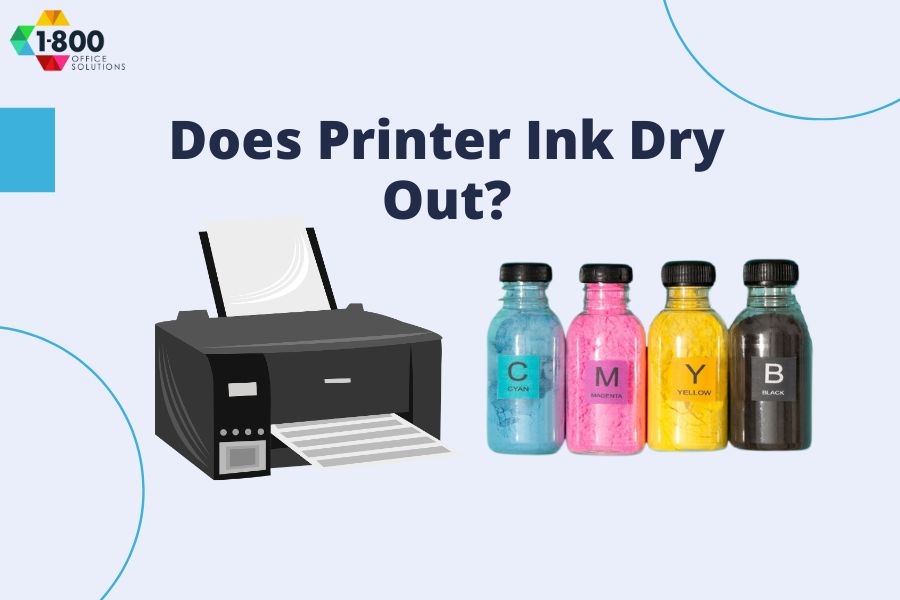Does Printer Ink Dry Out? Risks of a Dormant Printer Fleet
Does Printer Ink Dry Out
As a Printer Technician, one often hears the question: “Does printer ink dry out?” The answer is yes. The ink inside a printer’s ink cartridges, especially those in an inkjet printer, can indeed dry up if left unused for extended periods of time. The risk of cartridges drying out and resulting in poor print quality is heightened when printers lay dormant. Dry ink cartridges can clog the printhead, leading to streaky or unclear prints. Moreover, cartridges have expiration dates, further complicating this issue.
Modern printers are designed to prevent printer ink from drying by keeping the ink flowing, yet an extended period of inactivity can thwart these efforts. Improper storage can also cause cartridges to dry up quickly. A cartridge may be rendered unusable if stored in direct sunlight or not kept in an upright position.
Do Laser Printers Dry Out?
Venturing into the world of laser printing, let’s break down the myth of drying toner. Unlike the ink in an inkjet cartridge, the toner in a laser printer is essentially a fine powder that won’t dry out. When it comes to the life expectancy of a printer cartridge, it is not the drying out that concerns users; rather, it’s the wear and tear on the print head or the nozzle that could affect print quality over time.
However, there’s a twist in the tale when it comes to inkjet cartridges. If not used frequently, the ink can dry out or the print head can get clogged, leading to printing problems. This is why it’s recommended to print something at least once a week if you use your printer infrequently.
Additionally, improper storage of cartridges can cause the ink to evaporate, which could cause problems when you’re ready to print. To properly store your cartridges, keep them in an upright position in a cool place, below 85 degrees Fahrenheit. This helps keep the ink still wet, and prevent the ink cartridge from drying out.
Do Ink Cartridges Dry Out?
As a solitary moon sails across the inky night sky, consider the plight of unused inkjets. Just like the moon’s surface sits untouched for long periods of time, so too can toner cartridges if not used regularly. From an observer’s perspective, the scene might seem calm and serene, but the reality is much different. The tranquility conceals the fact that ink cartridge dries out and can lead to issues such as clogged printheads and inferior prints.
Now, imagine being able to fix dried up cartridges with a few simple steps. First, turn the printer off and then carefully remove the opened cartridges. Gently clean the printheads using a soft cloth dampened with warm water. This, akin to a shower after a dusty day, can often revitalize the cartridges. Once cleaned, keep your ink cartridges in an upright position in a cool, dark place. This is akin to storing wine appropriately to preserve its flavor and quality.
How to Prevent Printer Ink From Drying Out
Avoid utilizing expired print cartridges as cartridges can dry, damaging the equipment. Instead, consider new ink cartridges. For cost-effectiveness, manual refills are an option. However, ensure to prime your cartridges post-refill to keep ink flowing and prevent dried-out disruptions.
Regarding storage, keep the cartridges in environments away from warmth. High temperatures can negatively affect ink and toner. Old ink, if not used for an extended period of time, can solidify, which hampers the print results. Regular usage helps to keep printer ink from drying. Implement cleaning cycle frequently and print every few days to maintain efficiency.
1. Using Expired Cartridges
Moving forward from the reality that toner cartridges use can indeed become expired, a deeper understanding is required to prevent such mishaps. An expired toner powder container is like a ticking time bomb for your equipment, potentially causing an expensive head-cleaning process. Take care to check the dates when purchasing toner containers, often found on the side of the container or its box. Be alert, as some discount retailers may attempt to sell expired products, disregarding your privacy policy.
To ensure the longevity of your equipment, store the cartridges with care. Maintain a stable room temperature and keep them away from heat sources and direct sunlight. Remember, even when not in use, the toner powder may be affected by poor storage conditions.
2. Manually Refilling Cartridges
Transitioning from the topic of ink cartridges drying out, let’s delve into the technicalities of replenishing pigment reserves at home. Manually refilling vessels can seem like an economical solution, but it often leads to more complications than it solves.
Introducing air into the pigment supply during the refilling process can cause the pigment to harden and the dispensing apertures to become blocked. This not only hampers the device’s performance, but can also induce a plethora of mechanical issues, making the entire process rather counterproductive.
A better alternative would be to purchase a new pigment supply or opt for a printer toner, which lasts longer. Run regular print head cleaning cycles to ensure the dispensing apertures remain unblocked.
3. Storing Cartridges in Warm Temperatures
The caress of warmth can also be an enemy, particularly to those refill cylinders brimming with vibrant hues meant for your paper. Heat, uninvited and pervasive, can stealthily invade, distorting the performance and vitality of these essential tools.
Safeguarding these color containers requires maintaining a steady room climate, devoid of excessive warmth or humidity. A cool, arid environment, such as within a desk drawer, offers refuge, as long as it’s away from direct sunbeams or heat sources.
Yet, even with the most optimal storage conditions, remember to print as much as possible. Regular printing activity keeps the colors flowing and vibrant, preventing potential blockages. Print every couple of weeks or so to keep these color vessels at their optimum performance level.
4. Using Old Ink
As a seasoned printer technician, let’s delve into the pitfalls of letting the pigment sit idle inside the equipment for too long. Resting idle, the pigment can transform into an unworkable sludge rendering the equipment useless. This issue often leads to wasted resources and unnecessary expenses.
The ideal solution to this issue is more frequent printing. A simple page of text or a colourful image can do the trick. Regular utilization can help maintain the fluidity of the pigment, ensuring smooth operation. The rule of thumb is to print every couple of weeks. Another useful measure is to initiate regular maintenance cycles and pigment tests. Regular maintenance checks and pigment tests can prove instrumental in keeping the delivery pathways clear, ensuring the equipment remains in optimal condition.
How Long Does Printer Ink Last Before It Dries Up?
Bridging the knowledge gap from averting desiccation of the colorant in the printing device to the lifespan of the colorant before desiccation occurs, one can pose the question, “How long does it last before it succumbs to drying?” In the realm of printing, this is a common query, often clouded with various answers.
The lifespan of the colorant before desiccation is not set in stone, as it depends on several factors. The environment where the device is stored can significantly influence the duration. A humid environment can prolong the life of the colorant, while a dry one can shorten it.
Regular utilization can also play a critical role. Ideally, a regular colorant application routine would keep the colorant from drying. Here’s a handy tip: Aim to print every few days. This will not only maintain a colorful output but also prevent the colorant from turning into a desiccated mass.
How to Fix Dried-up Ink Cartridges
Transitioning from the lifespan of your imaging unit’s vital liquid, it’s essential to tackle the unfortunate eventuality of a solidified pigment holder. The key to rejuvenating a desiccated pigment holder lies within a unique process that, if followed, can potentially restore its function.
A beginning step to consider would be initiating a thorough cleansing routine. This operation works wonders by preparing the pigment holder, especially if solidified pigment has led to a blockage. The cleansing operation’s primary intention is to dissolve the hardened pigment, facilitating a smoother flow and enabling print every time.
By performing this dedicated cleansing operation, there’s a chance of restoring the pigment holder to its original functional state. It’s crucial to keep in mind that this kind of problem is more likely to appear if the imaging equipment stays idle for long durations. Therefore, a regular printing schedule might be beneficial in maintaining the pigment holder’s optimum functionality.
The Best Way to Ensure Fresh Printer Ink
Embarking on the journey towards vibrant, fresh pigment starts with subscribing via email for the latest tips. The road then leads to mastering the art of meticulously sanitizing thermal label device heads, an essential step that ensures consistent color intensity. Next, the magic of merging multiple scanned pages into one PDF becomes necessary, preserving the vibrancy of the original documents.
Lastly, the trip concludes with the exploration of DIY repair techniques for the office duplication apparatus. Remember to print every once in a while to keep the colorful essence lively. Equip oneself with these skills, and the path to unfading hues is guaranteed.
Subscribe by Email
Drifting elegantly away from the trials and tribulations of dried-up ink, imagine a world where the latest printing tips, tricks, and how-to guides appear magically in your inbox, as fresh as the morning dew. Welcome to the future of printing education, brought to you through the power of email subscription. With the click of a button, become part of a community that thrives on the pursuit of printing perfection.
Stay ahead of the curve, armed with the knowledge to tackle challenges from cleaning thermal label printer heads to scanning multiple pages into one PDF. Enjoy the satisfaction of mastering DIY office copy machine repairs, all without leaving the comfort of your inbox. Print every email, knowing each one brings a new opportunity to learn, grow, and print with confidence.
How to Clean Printer Heads on Thermal Label Printers
Shifting gears from the arid woes of expired printing fluid, the focus now falls on maintaining thermal label printers. Thermal label printers, the silent workhorses of the office, require regular maintenance to ensure their optimal performance. Cleaning their heads becomes an essential part of this routine.
Envision a small device, a thermal label printer, sitting in the corner of the office, tirelessly printing labels. Time and continuous use inevitably lead to residue build-up on its heads. To clean, power off the device first, and carefully remove the labels. Then, use a lint-free cloth soaked in isopropyl alcohol to gently wipe the heads. Make an effort to clean after every roll change to maintain effectiveness.
How to Scan Multiple Pages Into One Pdf
Transitioning from the topic of dried-up ink solutions, let’s delve into the realm of document digitization. Specifically, consider the technique of scanning multiple pages into one PDF document. It’s not just about pressing a button and hoping for the best. It demands a meticulous approach to ensure every detail is captured and compiled correctly, a task that echoes a symphony conductor’s role in harmonizing a concerto.
Start by arranging your documents in the correct sequence, then place them in the scanner. Set the scanning parameters and always remember to select the ‘Multiple Pages’ option. Print every scanned page to ensure the quality before saving all pages into a single PDF. This process, done properly, can transform stacks of paper into a neat, easily accessible digital file.
Diy Office Copy Machine Repairs You Can Do
Veering away from the subject of ink preservation, let’s delve into an equally important matter: performing simple repairs on the office copier. Fear not, these are tasks that don’t require calling in a service technician. With an understanding of the machine’s mechanisms, maintaining the copier’s functionality becomes a breeze.
Begin with regular cleaning of the machine’s surfaces, inside and out. This keeps dust from entering the internal mechanisms. Don’t forget to safely clean the glass surface with a glass cleaner to maintain optimal copy quality.
One must also make it a habit to print every day. This simple act keeps the machine’s components active, preventing mechanical issues from occurring due to inactivity.
Conclusion
In a world where technology is abuzz, one must not neglect seemingly minor details such as maintaining the freshness of pigments in printing equipment. Not doing so can risk the health of the equipment, leading to a standstill in operations. The key to averting this is to print every so often, as it helps keep the pigments soft and ready for optimal performance.
Even with the most diligent of efforts, there can be instances when the colorant hardens. But fret not, as this is not the end of the road. With a little knowledge and a handful of techniques, one can restore the pigment’s fluidity, ensuring the equipment runs smoothly. Thus, it is crucial to understand the problems that arise with dormant printing equipment, the ways to prevent it, and techniques to restore hardened pigments to ensure the longevity of the equipment.












